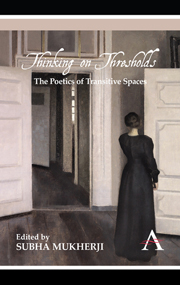Book contents
- Frontmatter
- ACKNOWLEDGEMENTS
- Contents
- List of Illustrations
- Notes on Contributors
- Introduction
- Part One Doors, Windows, Entries
- 1 Windows: Looking In, Looking Out, Breaking Through
- 2 ‘Zero…Zero…and Zero’: Permeable Walls and Off-stage Spaces
- 3 ‘The Queer Part Doors Play’ in Nabokov's Laughter in the Dark
- 4 ‘Invasion from Outer Space’: The Threshold of Annunciations
- Part Two Lives and Narratives, Territories and Worlds
- Part Three Matter, Mind, Psyche
- Part Four Reading, Writing, Playing, Listening
- Select Bibliography (including Discography)
2 - ‘Zero…Zero…and Zero’: Permeable Walls and Off-stage Spaces
from Part One - Doors, Windows, Entries
Published online by Cambridge University Press: 05 March 2012
- Frontmatter
- ACKNOWLEDGEMENTS
- Contents
- List of Illustrations
- Notes on Contributors
- Introduction
- Part One Doors, Windows, Entries
- 1 Windows: Looking In, Looking Out, Breaking Through
- 2 ‘Zero…Zero…and Zero’: Permeable Walls and Off-stage Spaces
- 3 ‘The Queer Part Doors Play’ in Nabokov's Laughter in the Dark
- 4 ‘Invasion from Outer Space’: The Threshold of Annunciations
- Part Two Lives and Narratives, Territories and Worlds
- Part Three Matter, Mind, Psyche
- Part Four Reading, Writing, Playing, Listening
- Select Bibliography (including Discography)
Summary
The characteristic setting of late nineteenth century realist theatre is the room, a domestic space enclosed by walls on three sides of the stage, and often by a ceiling too, with the fourth side open to the auditorium. The fundamental conceit of illusionist staging is that the audience look in on another, self-contained, world. The actors cross the threshold from the real private space of the dressing room into the public space of the stage as if they were entering the private space of a domestic room from the public world outside. The practice of darkening the auditorium, widespread by the end of the century, helped concentrate audience attention on a facsimile world, parallel to, rather than directly interactive with, their own. The proscenium arch framing the stage figured as an imaginary barrier between stage and auditorium. It was, in Jean Jullien's words, ‘a fourth wall, transparent for the public, opaque for the actor’. Jullien was writing in response to the stagings at André Antoine's Théâtre Libre, in Paris, but the phrase was quickly appropriated as a general shorthand for the new realistic theatre that emerged throughout Europe in response to Zola's polemics, Ibsen's plays and reports of Antoine's stagings. This imaginary barrier, not-quite-wall and not-quitewindow, is fundamental to the achievement as well as the contradictions inherent in illusionist theatre.
In illusionist theatre, the set, a temporary structure, must appear permanent, its walls seem solid, and the actors who appear within it must seem to be the characters they impersonate.
- Type
- Chapter
- Information
- Thinking on ThresholdsThe Poetics of Transitive Spaces, pp. 17 - 28Publisher: Anthem PressPrint publication year: 2011



